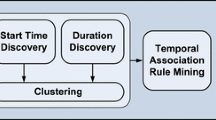Abstract
In the last decades, datasets have emerged as an essential component in the process of generating automated Activity Recognition (AR) solutions. Nevertheless, some challenges still remain: the lack of recommendations about which kind of information should be represented inside a dataset has resulted in the implementation of a variety of different non-standardized formalisms. On the other hand, this information is usually not sufficient to fully characterize the dataset. To address these challenges, this paper introduces a series of recommendations in the form of a dataset model with a well-defined semantic definition, for supporting those who are responsible for the creation, documentation and management of datasets. In addition, in order to better characterize datasets from a statistical point-of-view, we describe eight statistical analyses which should be included as additional measures within the dataset itself. We have validated our concepts through retrospectively analyzing a well-known dataset.
Access this chapter
Tax calculation will be finalised at checkout
Purchases are for personal use only
Preview
Unable to display preview. Download preview PDF.
Similar content being viewed by others
References
Chen, L., Nugent, C.D., Biswas, J., Hoey, J.: Activity recognition in pervasive intelligent environments, vo. 4. Springer Science & Business Media (2011)
Cook, D., Schmitter-Edgecombe, M., Crandall, A., Sanders, C., Thomas, B.: Collecting and disseminating smart home sensor data in the CASAS project. In: Proc. of the CHI Workshop on Developing Shared Home Behavior Datasets to Advance HCI and Ubiquitous Computing Research (2009)
Cook, D.J., Das, S.K.: How smart are our environments? an updated look at the state of the art. Pervasive and Mobile Computing 3(2), 53–73 (2007)
Gamma, E., Helm, R., Johnson, R., Vlissides, J.: Design patterns: elements of reusable object-oriented software. Pearson Education (1994)
Katz, S., Downs, T.D., Cash, H.R., Grotz, R.C.: Progress in development of the index of ADL. The Gerontologist 10(1 Part 1), 20–30 (1970)
Nugent, C.D., Finlay, D.D., Davies, R.J., Wang, H.Y., Zheng, H., Hallberg, J., Synnes, K., Mulvenna, M.D.: homeML – An open standard for the exchange of data within smart environments. In: Okadome, T., Yamazaki, T., Makhtari, M. (eds.) ICOST. LNCS, vol. 4541, pp. 121–129. Springer, Heidelberg (2007)
Nugent, C.D., Mulvenna, M.D., Hong, X., Devlin, S.: Experiences in the development of a smart lab. International Journal of Biomedical Engineering and Technology 2(4), 319–331 (2009)
Paton, N.W., Díaz, O.: Active database systems. ACM Computing Surveys (CSUR) 31(1), 63–103 (1999)
Philipose, M., Fishkin, K.P., Perkowitz, M., Patterson, D.J., Fox, D., Kautz, H., Hahnel, D.: Inferring activities from interactions with objects. IEEE Pervasive Computing 3(4), 50–57 (2004)
Serna, A., Pigot, H., Rialle, V.: Modeling the progression of Alzheimer’s disease for cognitive assistance in smart homes. User Modeling and User-Adapted Interaction 17(4), 415–438 (2007)
Turaga, P., Chellappa, R., Subrahmanian, V.S., Udrea, O.: Machine recognition of human activities: A survey. IEEE Transactions on Circuits and Systems for Video Technology 18(11), 1473–1488 (2008)
Vail, D.L., Veloso, M.M., Lafferty, J.D.: Conditional random fields for activity recognition. In: Proceedings of the 6th International Joint Conference on Autonomous Agents and Multiagent Systems, pp. 235. ACM (2007)
Van Kasteren, T., Noulas, A., Englebienne, G., Kröse, B.: Accurate activity recognition in a home setting. In: Proceedings of the 10th International Conference on Ubiquitous Computing, pp. 1–9. ACM (2008)
Author information
Authors and Affiliations
Corresponding author
Editor information
Editors and Affiliations
Rights and permissions
Copyright information
© 2015 Springer International Publishing Switzerland
About this paper
Cite this paper
Patara, F., Nugent, C.D., Vicario, E. (2015). Recommendations for the Creation of Datasets in Support of Data Driven Activity Recognition Models. In: Geissbühler, A., Demongeot, J., Mokhtari, M., Abdulrazak, B., Aloulou, H. (eds) Inclusive Smart Cities and e-Health. ICOST 2015. Lecture Notes in Computer Science(), vol 9102. Springer, Cham. https://doi.org/10.1007/978-3-319-19312-0_7
Download citation
DOI: https://doi.org/10.1007/978-3-319-19312-0_7
Published:
Publisher Name: Springer, Cham
Print ISBN: 978-3-319-19311-3
Online ISBN: 978-3-319-19312-0
eBook Packages: Computer ScienceComputer Science (R0)




